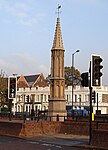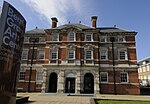Municipal Borough of Tottenham
Districts abolished by the London Government Act 1963Districts of England created by the Local Government Act 1894History of local government in London (1889–1965)History of local government in MiddlesexHistory of the London Borough of Haringey ... and 4 more
London geography stubsMunicipal boroughs of EnglandTottenhamUse British English from August 2017

Tottenham () was a local government district in north east Middlesex from 1850 to 1965. It was part of the London postal district and Metropolitan Police District.
Excerpt from the Wikipedia article Municipal Borough of Tottenham (License: CC BY-SA 3.0, Authors, Images).Municipal Borough of Tottenham
Forster Road, London Tottenham (London Borough of Haringey)
Geographical coordinates (GPS) Address Nearby Places Show on map
Geographical coordinates (GPS)
| Latitude | Longitude |
|---|---|
| N 51.592 ° | E -0.072 ° |
Address
Forster Road
Forster Road
N17 6UT London, Tottenham (London Borough of Haringey)
England, United Kingdom
Open on Google Maps









